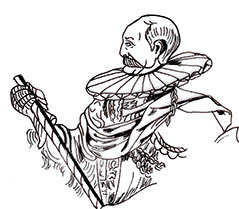Tunafors was first
Eskilstuna is often called the town of blacksmiths and ironworkers. It all started with Duke Carl (later King Karl IX), the only son of Gustav Vasa to have inherited his father’s interest in the iron industry. He appreciated the value of his mines, paddling furnaces, and foundries, and while continuing his father’s work and developing his iron companies, he added many more.
 |
| Duke Carl, from a copperplate engraving by Hieronymus Nützel, dated 1596. Sketch by the author. |
One of his inherited commitments was a collection of smithies, each over a century old, in “Thuna Fors” (Tunafors) by falls of the Eskilstunaån River. Here, Duke Carl found all he needed to manufacture iron products on a large scale. At the end of the 16th century, he opened workshops in this little community to manufacture nails, which were in demand in vast quantities in those days. Soon, weapons – such as halberds, pistols, and muskets – also became some of Tunafors’s staple products.
During the reign of Gustav II Adolf, the government leased the workshops out to Dutchmen Hans Leffler, Thomas Blommaert, Henrik Lohe, and Louis de Geer, each of whom continued the tradition of manufacturing weapons.
Today’s locks and security solutions
Welcome to ASSA ABLOY’s product pages for more information about today’s locks, access control, mobile keys with NFC, door automatics and more. In the ASSA ABLOY solution pages you can experience lock and security solutions for any door opening.